Table of Contents
- 上文提要
- 学习目标
- 学习内容
- 课前准备
- 1. 创建表的时候定义列级约束
- 2. 创建表的时候定义表级约束
- 3. 为表的属性定义默认值
- 4. 如果在创建表的时候,没有为某列定义默认值,缺省的默认值是空值null。
- 5. 创建表时使用自增数据类型
- 6. 使用现有的表创建新表
- 课程作业
- 往期内容
- [openGauss每日一练第 13 天](https://www.modb.pro/db/579711)
- [openGauss每日一练第 12 天](https://www.modb.pro/db/579545)
- [openGauss每日一练第 11 天](https://www.modb.pro/db/579543)
- [openGauss每日一练第 10 天](https://www.modb.pro/db/579480)
- [openGauss每日一练第 9 天](https://www.modb.pro/db/579413)
- [openGauss每日一练第 8 天](https://www.modb.pro/db/578921)
- [openGauss每日一练第 7 天](https://www.modb.pro/db/578407)
- [openGauss每日一练第 6 天](https://www.modb.pro/db/577681)
- [openGauss每日一练第 5 天](https://www.modb.pro/db/577665)
- [openGauss每日一练第 4 天](https://www.modb.pro/db/577626)
- [openGauss每日一练第 3 天](https://www.modb.pro/db/576102)
- [openGauss每日一练第 2 天](https://www.modb.pro/db/575008)
- [openGauss每日一练第 1 天](https://www.modb.pro/db/574657)
本次学习,学习表的约束、表的默认值、自增类型等技术。
上文提要
在第十三课中,我们学到了一些数据库基础操作,主要为表的创建、搜索路径和访问方法等。
复习一下:openGauss每日一练第 13 天。
学习目标
学习表的约束、表的默认值、自增类型等技术。
- 创建表的时候定义列级约束
- 创建表的时候定义表级约束
- 为表的属性定义默认值
- 如果在创建表的时候,没有为某列定义默认值,缺省的默认值是空值null。
- 创建表时使用自增数据类型
- 使用现有的表创建新表
学习内容
课前准备
连接数据库 #第一次进入等待15秒 #数据库启动中... su - omm gsql -r复制
1. 创建表的时候定义列级约束
-- 创建表的时候为表定义列级约束:在列级定义了primary key约束(id列)和not null约束(name列)。 drop table if exists test; create table test( id bigint primary key, name varchar(50) not null, age int ); --插入数据 insert into test values(1,'user1',50); --查看数据 select * from test; --查看约束 \d test复制
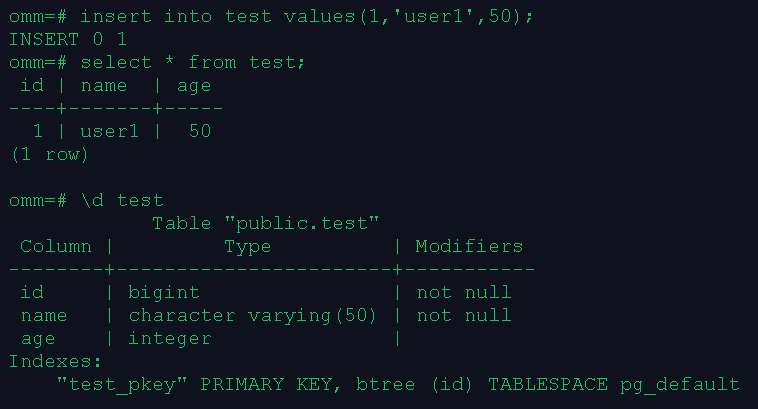
2. 创建表的时候定义表级约束
--创建表时定义表级约束 执行下面的SQL语句,在创建表的时候为表定义表级约束: #这里在表级定义了primary key约束(id列),在列级定义了not null约束(name列)。 drop table if exists test001; create table test001( id bigint, name varchar(50) not null, -- 创建列级not null约束 age int, primary key(id) -- 创建表级约束 ); insert into test001 values(1,'user1',50); select * from test001; \d test001复制
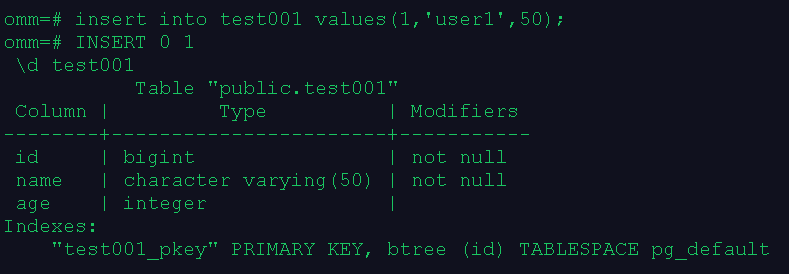
3. 为表的属性定义默认值
--执行下面的语句,在创建表的时候为表的某个列定义默认值: drop table if exists test002; create table test002( id bigint, name varchar(28) not null, age int default 20, -- 为该列定义默认值为20 primary key(id) ); --下面的SQL insert语句,在向表test插入数据时,没有提供age列的值: insert into test002(id,name) values(1,'user1'); insert into test002(id,name) values(2,'user2'); select * from test002;复制
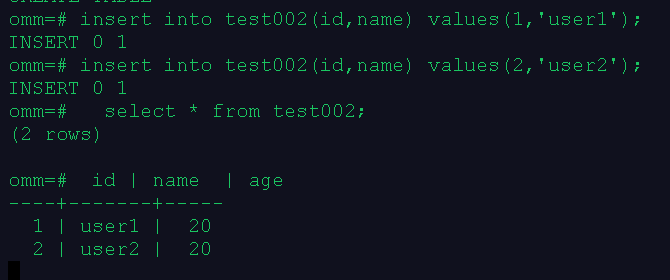
4. 如果在创建表的时候,没有为某列定义默认值,缺省的默认值是空值null。
-- 未定义age列的默认值,如果插入数据时未提供该列的值,则将默认插入空值null drop table if exists test; create table test( id bigint, name varchar(50) not null, age int, primary key(id) ); insert into test(id,name) values(1,'user1'); select * from test;复制
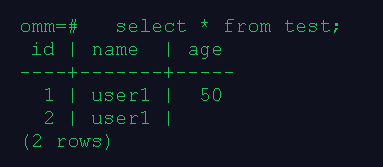
此处由于之前已经在test表中插入了id=1的数据,所以insert时id改为2。
5. 创建表时使用自增数据类型
商品的编号通常按顺序递增。这种情况可以使用serial数据类型。最简单方法直接使用serial数据类型。
-创建一个带有serial数据类型的测试表invoice: drop table if exists invoice; create table invoice(invoicenum serial NOT NULL,name varchar(20)); --为表invoice插入3条记录,并查看插入数据后的表的数据: insert into invoice(name) values('user1'); insert into invoice(name) values('user2'); insert into invoice(name) values('user3'); --可以看到每插入一条记录到表invoice后,列invoicenum的值会自增1。 select * from invoice;复制

自增列可以不用插入值。
6. 使用现有的表创建新表
--执行下面的SQL语句,将创建新表,并且会将旧表的数据拷贝给新表: DROP TABLE if exists newtestwithdata; CREATE TABLE newtestwithdata AS SELECT * FROM invoice; SELECT * FROM newtestwithdata;复制

--执行下面的SQL语句,创建和旧表的表结构相同的新表,但是不会将旧表的数据拷贝给新表: DROP TABLE if exists testnewwithoutdata; CREATE TABLE testnewwithoutdata AS SELECT * FROM invoice WHERE 1=2; SELECT * FROM testnewwithoutdata;复制

课程作业
1.创建表的时候定义列级约束
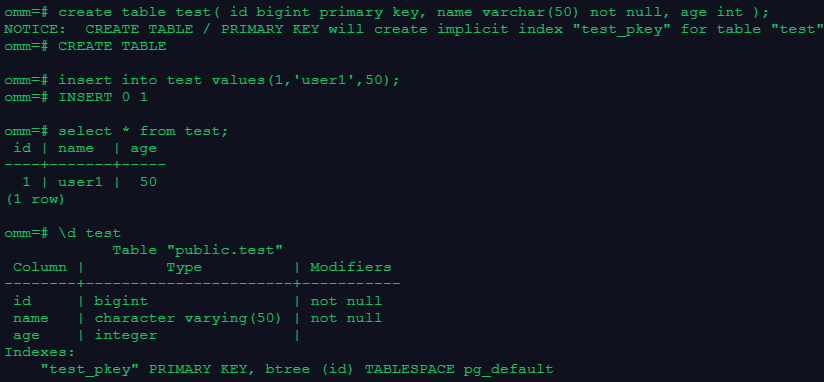
2.创建表的时候定义表级约束
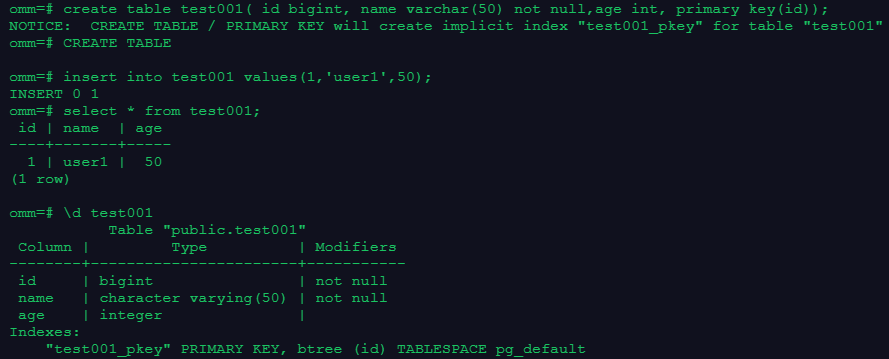
3.为表的属性定义默认值

4.如果在创建表的时候,没有为某列定义默认值,缺省的默认值是空值null

5.创建表时使用自增数据类型

6.使用现有的表创建新表
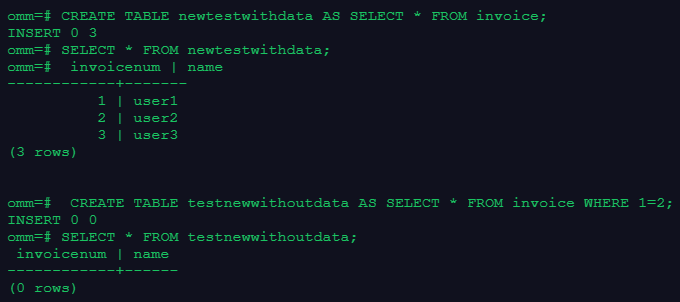
往期内容
openGauss每日一练第 13 天
openGauss每日一练第 12 天
openGauss每日一练第 11 天
openGauss每日一练第 10 天
openGauss每日一练第 9 天
openGauss每日一练第 8 天
openGauss每日一练第 7 天
openGauss每日一练第 6 天
openGauss每日一练第 5 天
openGauss每日一练第 4 天
openGauss每日一练第 3 天
openGauss每日一练第 2 天
openGauss每日一练第 1 天
「喜欢这篇文章,您的关注和赞赏是给作者最好的鼓励」
关注作者
【版权声明】本文为墨天轮用户原创内容,转载时必须标注文章的来源(墨天轮),文章链接,文章作者等基本信息,否则作者和墨天轮有权追究责任。如果您发现墨天轮中有涉嫌抄袭或者侵权的内容,欢迎发送邮件至:contact@modb.pro进行举报,并提供相关证据,一经查实,墨天轮将立刻删除相关内容。
评论
目录






